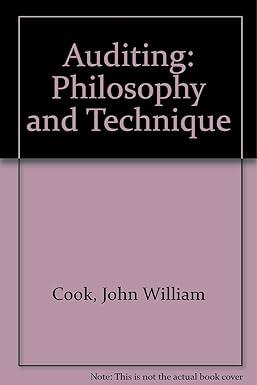Question
Term Project You will both write and orally present your project. Your write-up of the project is due at the beginning of the class meeting
Term Project You will both write and orally present your project. Your write-up of the project is due at the beginning of the class meeting on Monday, November 4, 2019. The teacher expects (but does not guarantee) that students will then present their projects sometime during the remaining class periods, but we will not yet have completed the chapter presentations, so the exact schedule will be worked out later. You may use any format which is sensible to the intended audience. (In this case, the intended audience is Dr. Grayson.)
You may discuss the project with anyone you wish, including with practicing accountants. However, your write-up and your oral presentation must be your own.
1. Find a commercial auditable entity (a company, other organization, or part of one). If you cannot find a "live" one, find a "dead" one at the United States Bankruptcy Court. In Brooklyn, NY, the Bankruptcy Court is located at 271-C Cadman Plaza East, Suite 1595, Brooklyn, NY 11201- 1800. You may not use an organization which is not a for-profit entity. You may not use a church, synagogue, mosque, nor other religious entity.
2. Define the auditable entity.
3. Describe the business model of the entire entity. How does the entity receive resources? How does the entity earn a profit? Merely saying that it sells something does not tell how it earns a profit; I could set up a business selling dollar bills for five cents each, and I might sell a lot of dollar bills, but I would not earn a profit from this business. For example, if it is a for-profit business, how does it attract customers? Are its customers buying staple goods, convenience goods, shopping goods, or luxury goods? Explain why these are staple goods, convenience goods, shopping goods, or luxury goods. You should have learned these terms in your first marketing course. (If you were to audit such a not-for-profit organization in the future, after graduation, does it receive funds through contributions, member dues, contracts to provide social services, etc.?)
4. If the auditable entity is less than the entire entity, how does the auditable entity fit into the entire entity? If the auditable entity is the entire entity, say so.
5. What is the particularized (not general) professional literature which an auditor should be aware of, if applicable? Do not include the material in the standards and related rules or general audit manual, but do include particular FASB statements (SFAS's), ASB statements, industry audit guides available from the AICPA, applicable standards from the GASB, regulatory accounting requirements, etc. which apply to this client. Two good sources to use to check for such professional literature are the AICPA (www.aicpa.org) and a related store (www.cpa2biz.com). Also check any professional literature we have at this educational institution, including in electronic form.
6. Track down and read the COSO (Council of Sponsoring Organizations) document on risk, if you can do so. (Note to students: The Department of Accounting has been successful during the past two to three years in obtaining a site license to various authoritative professional literature. If we are able to do so again this academic year, check to see whether the COSO literature is included.) Tell whether you read the document. Whether or not you actually read the document, tell what you did to try to find the document.
7. What are the most important business risks to the client entity associated with this entire entity and with this auditable entity? (Think of business risks to the client entity as things which could go wrong, or other things which could have a significant negative effect on the client's business.)
8. What are the most important business risks to the audit firm associated with this entire entity and with this auditable entity? (Think of business risks to the audit firm as things which could happen that would somehow taint the reputation of the audit firm, even though the audit firm did its work correctly and rendered the correct report.)
9. What are the most important audit risks associated with this entire entity and with this auditable entity? If you were actually doing a financial- statement audit of the entity, what would you do to assure that you could gather sufficient appropriate audit evidence to formulate the proper opinion on the financial statements of this entity? (Think of audit risks as those things peculiar to the client and to the auditable entity which might make the auditors think they had done a good job which supports an unqualified opinion when in fact the opinion should be qualified, disclaimed, or adverse.)
I'd like to know how to complete this project?
Any help would be grateful
Step by Step Solution
There are 3 Steps involved in it
Step: 1

Get Instant Access to Expert-Tailored Solutions
See step-by-step solutions with expert insights and AI powered tools for academic success
Step: 2

Step: 3

Ace Your Homework with AI
Get the answers you need in no time with our AI-driven, step-by-step assistance
Get Started


